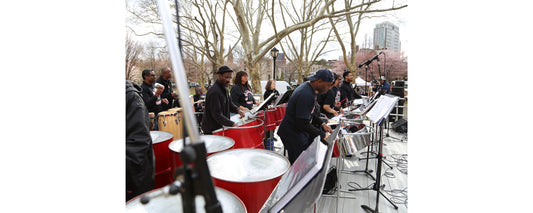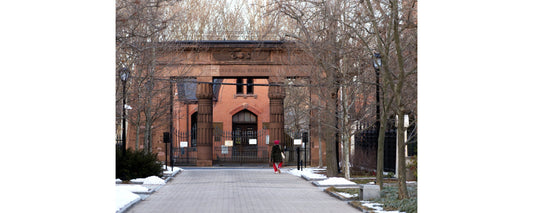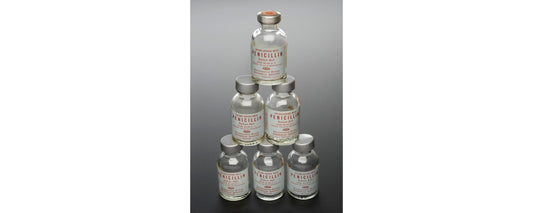With its creaky stairs and parquet floors, the Ely Center of Contemporary Art is a perfect venue for the work of Gary Sczerbaniewicz, one of three artists who heeded ECOCA’s open call in 2021 and whose work is now on view in January Solos. Many of Sczerbaniewicz’s model interiors depict similarly antique spaces, though his are abandoned, neglected and scaled down to dollhouse size. The artist’s shadow box rooms present the detail of ruin: peeling and water-stained wallpaper, a fraying electrical cord, scratched wood floors, rust stains dripping from a vent, all in meticulously detailed miniature. Viewing them at ECOCA gives them extra depth, as if they’re mirroring a dystopian version of the gallery space itself.
One series of Sczerbaniewicz’s models (2019-2021), which depicts the same room in various states of disrepair, takes for its titles snippets of a popular children’s prayer—Down to Sleep, I Pray the Lord, Before I Wake and My Soul to Take—which suggests the rooms as metaphors for their inhabitants, stripped at times to their plaster and lath like bodies separated from their souls. That question of body and soul is raised again in the virtuosic Folie à Deux (2021), with an added touch of humor. Here, the shadow box is a U-shaped tunnel with two windows that offer a view of two control rooms, mirror images of one another. They could come straight from the set design for a 1960s sci-fi flick, delighting the viewer with precise details: fluorescent lights in a drop ceiling, white tiled floors, gray metal desks with rolling chairs, a fire extinguisher, looseleaf binders, a microphone, a red emergency button—and, on one desk, a Ouija board, slyly suggesting that amid all this science might be a kernel of mysticism. The interior tunnel that connects these two command centers can be seen through a rear observation window in each. There, a metal device is wired to the gray folds of a brain. The passage narrows to an intriguing, cavelike but unseen center passage with ambient light spilling out of it. You almost feel as if you could crawl into it yourself to explore.
sponsored by
Through his architectural spaces, Sczerbaniewicz seems to be asking us to think, uncomfortably, about the spaces, both internal and external, that we inhabit ourselves. In Knee Vignette #1 (2016), for example, we encounter the dreary, wallpapered interior of a home with two mostly hidden stairways leading upward behind facing doors. Between them, a larger opening, surrounded by delicate white molding, frames a pink ooze of what could only be described as body tissue spilling into the living space. It’s as if our houses, as a proxy for ourselves, can only contain the messy private pieces of us for so long, until they inevitably ooze into view.
This theme of sometimes grotesque living forms carries into a downstairs gallery, where Hartford-based artist Matthew Dercole is working with an unusual medium: fungus. Dercole’s act of sculpting begins with cultivating these bumpy, lumpy fungi knobbed with nodules. Then he trims them with organic and inorganic materials—fur, grass, chopped up bits of rubber—and, often, frames them. Central to this exhibit is the installation remnant 27 (learner’s permit) (2021), a box trap propped up on a forked stick with a braided rope just waiting to be tugged. The bait is a fetal animal—a sheep, perhaps?—on a bed of fungus. Chopped bits of black rubber delineating the space give the organic feel of charcoal. Like each of Dercole’s pieces, this one is presented as a “remnant”—not unlike Sczerbaniewicz’s pieces, a vestige of life we’re being asked to examine more closely.
Refreshingly, ECOCA makes no move to tie these exhibits together. That impulse is left for the viewer to explore. But when I stepped into the dark first-floor gallery showing the work of the third January Solos artist, K. Sarrantonio, their multimedia works continued to speak to an emerging theme of ungainly living forms. In Sometimes Our Timing Was Bad (2021), side-by-side projections of naked buttocks sway at different rates. These video images both float inside two cubes of black wire and break through them to land on the far wall. A second video, What If It’s Like This Forever (II) (2021), plays similarly with out-of-sync movement. Here, three people each attempt a handstand or headstand on narrow side-by-side screens. One person is dressed in black, another in street clothes, a third in nothing at all. One kicks up into a handstand against a wall, the second teeters in a perpetual headstand, and the third, their back to us, painstakingly crawls their feet up the wall, trying to attain something like the pose of the other two. This poignant projection speaks to how diverse our bodies are, even when we’re attempting to do the same thing.
In their artist statement, Sarrantonio writes that they’re trying to figure out “how to make work about the body without showing the body.” That riddle could be said to drive the work of all three of these provocative artists.
January Solos
Ely Center of Contemporary Art – 51 Trumbull St, New Haven (map)
Mon, Wed, Thurs, Sun noon-5pm through 2/20
(203) 907-4151 | info@elycenter.org
www.elycenter.org/january-solos
Written by Kathy Leonard Czepiel. Images 1 and 3, featuring Gary Sczerbaniewicz’s Folie à Deux and Matthew Dercole’s remnant 27 (learner’s permit), photographed by Kathy Leonard Czepiel. Images 2 and 4, featuring Gary Sczerbaniewicz’s Folie à Deux and K. Sarrantonio’s Sometimes Our Timing Was Bad & What If It’s Like This Forever (II), provided courtesy of ECOCA.








